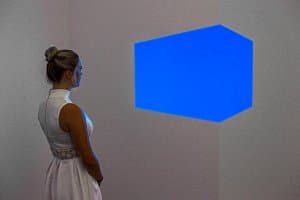

James Turrell
Learn moreShanta II (blue) 1970
Purchased 2014
More detail | PermalinkJames Turrell creates art with light, space and perception. In November 1966 he rented a studio in the Mendota Hotel building in Santa Monica, Los Angeles, and began working with the interior spaces, discovering, in the process, a ‘universe of possibilities’ and ‘ideas for a lifetime’s work’.[1] In sealing off the rooms and constructing walls and apertures to control the light entering the spaces, Turrell built ‘containers’ for light and in doing so experimented with different light effects. Cool, metallic and machine-like, Shanta II (blue) 1970 is from the body of work created at this time. Afrum 1966, a related work and the artist’s first Cross-corner projection, used a modified slide projector to persuade viewers that they were seeing a white cube of light levitating in the space.[2] Works in subsequent series show how Turrell’s concepts developed in new ways as he built more complex structures. By virtue of its carefully crafted form and ‘plumbed’ light Shanta II (blue) demonstrates the astonishing range and compelling possibilities created from variants of the simple principles of the Cross-corner construction series.
Turrell is best known for his life work, the Roden Crater. For the past four decades he has been creating a naked-eye observatory in an extinct cinder-core volcano on the edge of the Painted Desert in Arizona, a project that gathers together all types of his work and is one of the most extraordinary examples of Land art conceived in recent time. When complete, visitors to Roden Crater will experience specially calculated views of the sun and moon, and rare astronomical events. Some of these experiences, like the Gallery’s Skyspace, Within without 2010, are created to be viewed at a specific time of day, or rely on the alignment of celestial events. Others, like the Cross-corner projections or Cross-corner constructions, function at any time of the day. Whether he uses the sun, fluorescent tubes, neon, LEDs or the effects of contrast on paper, Turrell shows us the impact of light and the strengths and limitations of the human eye. Like all his work, Shanta II (blue) depends on experience, the process of seeing and the physical act of being present in the space. When there, we may wonder how the blue shape hovers in space, without perceiving the means of its construction.
Created with colour, Shanta II (blue) is linked to its projected, drawn and aquatinted versions.[3] The qualities of the shape are subtly changed through the various iterations. Shanta (white) 1967, for example, shows the cube from a different viewpoint, while in Afrum (white) 1967 it appears pushed against the wall. Shanta II (blue) looks less like an elongated cube and more as if it projects from the right-hand wall of the space. Despite the fact that the angled walls that form the aperture are readily apparent, the eye brings the blue-lit object forward to hover at the centre of the room. Like a Skyspace, where the oculus overhead makes the sky appear brighter and more painterly, the aperture focuses the viewer’s attention. As Nancy Spector points out, Turrell’s light works ‘give form to perception’.[4]
Lucina Ward
[1] Conversation between James Turrell and Craig Adcock, September 1986; see Adcock, ‘Light and space at the Mendota Hotel: The early work of James Turrell,’ Arts Magazine, vol 61, no 7, March 1987, pp 48–55; many other details about the Mendota Hotel period (1966–74) are sourced from this article, Adcock’s chapter in James Turrell: The art of light and space, University of California Press, Berkeley, 1990, pp 85–113, and David Anfam and James Turrell, James Turrell: Projection works 1966–69, Albion Gallery, London, 2004.
[2] Los Angeles County Museum of Art, see https://collections.lacma.org/node/215590, accessed 27 March 2018.
[3] Shanta (white) 1967 is part of the collection at the Whitney Museum of Art, New York; the red, pink, white, violet and pale blue versions, all 1968, are distributed through various private collections in the United States and Great Britain.
[4] Nancy Spector, James Turrell Afrum I (White) online catalogue entry, Guggenheim Museum, New York at http://www.guggenheim.org/new-york/collections/collection-online/artwork/4084, accessed 27 March 2018.

